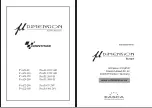
JUDO BIOSTAT-COMBIMAT
9
Installation
4.2
Requirements for the place of
installation
The room where the unit is installed must
be dry and frost free!
Unauthorised persons must not have
access to the water treatment device!
ATTENTION
(see chapter “Safety information and
dangers due to non-compliance”)
–
The ambient temperature must not
exceed 30 °C (86 °F)! Higher tempera-
tures or exposure to direct sunlight may
result in damage to the unit.
–
We recommend that the water treatment
devices is installed after a backwash
protective filter, to prevent particles of
dirt and sand being swept in.
–
Length of the power lead required is
approximately 1.5 m.
–
Wherever installed in smaller pipe sizes,
the connecting flange on the unit should
be supported using pipe clamps.
4.2.1 Installation position
ATTENTION
(see chapter “Safety information and
dangers due to non-compliance”)
Always install the water treatment device
in a vertical position (± 5°) to avoid impair-
ments of its function!
4.2.2 Power supply
ATTENTION
(see chapter “Safety information and
dangers due to non-compliance”)
A permanent power supply must be avail-
able. If the water treatment device is not
permanently supplied with power, it cannot
supply error warnings and will not treat
water passing through.
4.2.3 Mounting the built-in rotary
flange
The built-in rotary flange is used as a
connecting element between the pipe and
the water treatment device.
It is suitable for both horizontally and verti-
cally mounted pipes.
The installation height depends on the pipe
layout. The minimum installation height from
the floor to the rotary flange is 40 cm.
The built-in rotary flange must be
installed in the direction of flow. This is
marked by an arrow on the casting (see
fig. 1)
.
Failure to observe these instructions will
result in unit malfunction!
ATTENTION
(see chapter “Safety information and
dangers due to non-compliance”)
The face of the built-in rotary flange must be
in a vertical position! The built-in rotary
flange must be fitted to avoid any mecha-
nical stress as this can lead to major water
damage.
Health risks may arise from exposure to
water leaking from a damaged unit.
A power connection (230 V, 50 Hz),
which is available und permanently
switched on.
A splash-proof socket is required for
the power supply, in accordance with
the legal regulations for wet rooms.










































